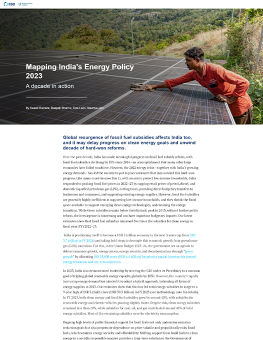
Mapping India's Energy Policy 2023
A decade in action
How has government support for energy in India evolved over the last decade? As India strives to become a USD 5 trillion economy over the next 3 years, what will its energy mix be? Is government support and taxation aligned with its long-term net-zero commitment?
-
#BREAKING | India's #energy #subsidies increased to USD 39.3 billion in FY 2023-the highest amount in 9 years.
-
India adopted a #hybrid approach in 2023-supporting both #fossilfuels & #cleanenergy to address the needs of a growing #economy. But #fossilfuelsubsidies remain five times higher than #cleanenergy.
-
India's #EV #subsidies reached an all-time high at USD 1.2 billion in 2023, with India emerging as one of the fastest-growing markets for EVs-but the future of #government #support remains unclear.
Mapping India's Energy Policy 2023 is the latest publication in a series of annual updates on government support for energy in India. This year's publication highlights the key shifts in India's energy policy over the last decade, between fiscal year (FY) 2014 and FY 2023.
We found that India's fossil fuel subsidies have declined by 59% since 2014—an accomplishment that many other large economies have struggled to achieve. However, the 2022 energy crisis—together with India’s growing energy demand—has led the country to bolster all forms of energy supplies and adopt a mixed approach to fossil fuels and clean energy.
Key Findings:
- India's mixed approach led its energy subsidies to increase to INR 3.2 lakh crore (USD 39.3 billion) in FY 2023—the highest amount in 9 years. Both clean energy and fossil fuel subsidies grew by around 40% from FY 2022.
- Fossil fuels subsidies remained five times the subsidies for clean energy in FY 2023.
- Following the 2022 energy crisis and soaring energy demand, India responded to peaking fossil fuel prices in 2022–23 by capping retail prices of petrol, diesel, and domestic liquefied petroleum gas (LPG), cutting taxes, providing direct budgetary transfers to businesses and consumers, and supporting existing energy supplies. As a result, oil and gas subsidies rose by 63% in FY 2023.
- On the other hand, renewable energy subsidies also grew to INR 14,843 crore (USD 1.8 billion) in FY 2023, an 8% increase over FY 2022, but remain low when compared to fossil fuels.
- During this period, India is also emerging as one of the fastest-growing markets for EVs, with EV subsidies reaching an all-time high in FY 2023—but the future of government support remains unclear.
- Besides energy subsidies, the study also aggregates annual data on capital expenditure of state-owned enterprises (SOEs) and lending by public financial institutions as critical state actors. It finds that new build-out plans of energy-related SOEs show early signs of diversification into clean energy, but spending remains too low to achieve India’s 2030 clean energy targets.
Based on these findings, the report also accompanies several recommendations for the consideration of policy-makers and relevant stakeholders. As India prepares for a full budget in July, the Government of India has an opportunity to design financial flows—starting with public financial flows under its direct control—consistent with its own net-zero targets and sustainable development.
Participating experts
You might also be interested in
Mapping India's Energy Policy 2022 (Update)
This study gathers and analyzes data on Indian government support for fossil fuels and clean energy for fiscal years 2014–2022.
Mapping India's Energy Policy 2022
Looking at how the Government of India has supported different types of energy from FY 2014 to FY 2021, this report aims to improve transparency, create accountability, and encourage a responsible shift in support away from fossil fuels and toward clean energy.
Mapping India's Energy Subsidies 2021: Time for renewed support to clean energy
This report estimates India's energy subsidies over seven years and analyzes the implications for national clean energy targets.
How to Target LPG Subsidies in India: Step 2. Evaluating policy options in Jharkhand
This report considers options for subsidy targeting in India by using a survey of over 900 households to analyze the distribution of LPG subsidies in the state of Jharkhand.